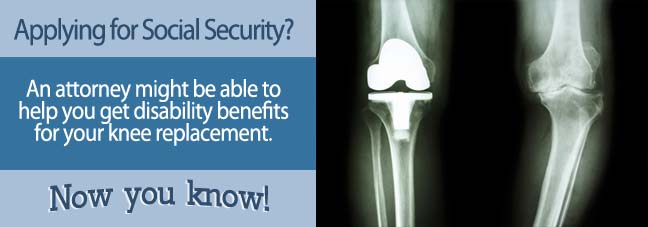Knee replacements are as common as they are difficult to deal with. Caused by anything from trauma to arthritis to the natural wear and tear of aging, knees are especially susceptible to damage. The resulting pain, surgery, medical costs, and recovery time can also be an added strain.
Luckily, if you or a loved one is currently coping with (or will be having) a knee replacement, disability benefits may be an option. Millions of Americans in need receive monthly Social Security benefits for severe medical conditions, including severe cases that result in surgery and elongated healing times. Continue below to see if your case may fit the requirements.
Step One: Determine how much your knee replacement limits you.
Knee replacements can cause multiple problems before and after surgery. However, disability benefits are reserved for people who are considered “totally and permanently disabled.” The Social Security Administration (SSA) defines this as a severe mental or physical affliction that will either a) last longer than one year, or b) result in death.
While this sounds extreme, it is still possible for knee replacement patients to receive benefits. Before we take a look at the specific medical requirements, we must first look at how your knee replacement hinders you in your daily life.
For example: most able-bodied people rely on their legs every day. After a knee replacement, big tasks like commuting or working can become too tricky without the reliable use of their legs. For people with active jobs like construction or landscaping, it can be impossible to return to work or work from home post-surgery. Even small tasks like cooking food, going to the bathroom, or cleaning the home may become difficult.
The more your knee replacement hinders you in your working and daily life, the more likely you are to receive disability benefits.

Step Two: Consult the Blue Book and retrieve test results to demonstrate your disability.
When the SSA looks over applications, they consider an applicant’s functionality (as described above) as well as their official diagnosis. Because knee replacements are rather common, it is important for the government to know why your situation is serious enough (and lengthy enough) to require monthly benefits. To ensure this, they compare every applicant’s diagnosis to the “Blue Book,” a list of all SSA-approved disabilities.
Knee replacements can qualify under two different listings in the Blue Book: “Major dysfunction of a joint(s) (due to any cause)” or “Reconstructive surgery or surgical arthrodesis of a major weight-bearing joint.”
- Major dysfunction of a joint(s) (due to any cause): To qualify here, applicants must demonstrate continued pain or abnormality of their knee joint and an inability to continue living effectively because of this. Applicants may also qualify here before receiving knee surgery, if they should decide to wait or seek alternative treatment.
- Reconstructive surgery or surgical arthrodesis of a major weight-bearing joint: To qualify here, applicants must show that they are unable to “ambulate effectively” due to their knee replacement. This means that applicants must have severe difficulty with walking or sustaining pace, as well as initiating, sustaining, or completing activities. If it is shown that the applicant’s condition will not greatly improve within a year, then it is very possible to receive benefits.
Step Three: Gather paperwork and prepare to fill out the application.
Aside from medical requirements, the Social Security disability application also requires financial information. The SSA uses this to further understand your lifestyle, your history, and determine which Social Security program you are better suited for.
One of the most important requirements is your work history. This is required for multiple reasons — it can:
- show when you began or stopped working to demonstrate when your knee problems became too much of an issue or required surgery.
- be used to calculate your history of contributing taxes to Social Security, to determine if you qualify for Social security disability insurance (SSDI)
- demonstrate unemployment or low income status to determine if your qualify for Supplemental Security Income (SSI)
It is also recommended that you prepare all relevant documents, including doctors’ physicians’ notes, hospitalization history, medication lists, bank statements, coworker/boss testimonies, and other general info before you begin the application. Anything you have that can help demonstrate your situation to the SSA is always helpful to include.
Once you’re ready, applications can then be filled out online or at your local Social Security office.
Contacting a Social Security Attorney
If disability benefits sound like a good fit for you, you may also want to consider consulting with a disability attorney. They can help when filling out applications, keeping paperwork organized, and aiding you in the appeals process if necessary. They also greatly improve your chances of winning your case.